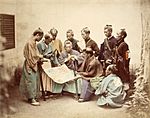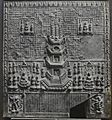Asuka period facts for kids
 |
|---|
|
The Asuka period (飛鳥時代, Asuka jidai) was an important time in the history of Japan. It lasted from about 538 AD to 710 AD. This period is sometimes called Suikochō-jidai, which means "period of the Suiko court."
The Asuka period gets its name from the Asuka region. This area is about 25 kilometers south of the modern city of Nara. The Asuka period connects the earlier Kofun period with the later Nara period.
Key Events of the Asuka Period
This timeline shows some of the most important things that happened during the Asuka period.
Important Dates
- 538: Buddhism arrived in Japan. It came from China through the Korean peninsula.
- 593: Prince Shōtoku became a regent for Empress Suiko. A regent is someone who rules for a king or queen who is too young or unable to rule.
- 600: The Yamato state sent its first official group of people to China. This was a diplomatic mission to build connections.
- 607: Prince Shōtoku built the famous Buddhist temple Hōryūji in a place called Ikaruga.
- 645 (Taika 1): Emperor Kōtoku moved the capital city. It moved from Asuka to Naniwa, which is near the Bay of Osaka.
- 645 (Taika 1): The Taika Reform began. This was a big change in how Japan was governed. It led to the creation of provinces across the country.
- 672: Prince Ōama, who later became Emperor Temmu, took the throne. He won a civil war called the Jinshin no Ran against Emperor Kōbun.
- 701 (Taihō 1): The Code of Taihō was announced. This was a set of laws that helped organize the government.
- 708 (Keiun 5): A place to make coins was set up in Ōmi. These coins were the first official Japanese money.
- 710 (Wadō 3, 3rd month): Empress Gemmei created a new capital city. This new capital was in Nara, and it was known as Heijō-kyō.
Gallery
See Also
- Metropolitan Museum of Art, Asuka and Nara Periods
- Japan-guide.com, Early Japan
Images for kids
-
A pitcher shaped like a dragon's head, with a Pegasus design. It is made of gilded bronze with silver. This piece is from the Asuka period (7th century) and was once a treasure of the Horyu-ji Temple. It is now at the Tokyo National Museum.
-
A bronze plaque showing Shaka giving a sermon. It is dated 698 AD and is from the Hase-dera Temple in Sakurai, Nara.
See also
 In Spanish: Período Asuka para niños
In Spanish: Período Asuka para niños







